#anyways. gentoo and stuff
Explore tagged Tumblr posts
Text
Animal Crossing Fish - Explained #137
Brought to you by a marine biologist and some very nice waddle-babies...
CLICK HERE FOR THE AC FISH EXPLAINED MASTERPOST!
So, I covered sea birds in general when I spoke about Gulliver/Gullivarrr. They are a fascinating group of birds that have members in the following Orders: Procellariiformes (albatross, petrels, and friends), Pelecaniformes (pelicans), Suliformes (gannets, cormorants, and friends), Phaethontiformes (the tropicbirds), and very specific families within Charadriiformes, such as the gulls of Laridae.
All of them make the ocean their home, flying over the vast seas, using their very acute senses of sight and smell to find meals in the endless blue. They all, can drink saltwater safely, all of them finding some way to get water in their very salty habitat through convergent evolution. Many of them are great swimmers as well, diving to depth to catch a meal. Then there are penguins, in Order Sphenisciformes, who take the sea bird life and take it many, many steps further.

The penguin villagers are frickin’ adorable. There are 13 of them in the game, many of which don’t represent any particular penguin species, although Tex is definitely an African Penguin (Spheniscus demersus), while Hopper is some kind of crested penguin in genus Eudyptes.

By Thomas Mattern - en:Image:SnaresPenguin (Mattern) large.jpg, CC BY 2.5, https://commons.wikimedia.org/w/index.php?curid=2427527
Anyway, yeah, penguins take living at sea to the extreme. Unlike all other sea birds that fly over the oceans, penguins gave up flying completely. They are totally flightless, adapting their wings into flippers for swimming. Like other water-bound birds, you’ll notice their legs are situated very far back on their bodies, giving them a more stream-lined shape. This helps in swimming, but it’s kind of a bitch on land, so you’ll notice most water birds and water fowl, like ducks, waddle awkwardly. In the water, they’re graceful af, though. Gentoo penguins are the fastest swimming bird, reaching speeds of 22 mph (36 kph) and the emperor penguin is the deepest diving bird, diving to depths of 1800 feet (550 m) to find food. They are mostly all small-fish eaters, pursuing their prey underwater. Unfortunately, penguins have many predators of their own, including sea lions, fur seals, leopard seals, orcas, and sharks. Being vigilante often means that penguins only enter the water to feed and avoid it otherwise. However, young penguins can be taken by land-based predators, too, as well as other seabirds, like skuas.

The ocean is a pretty cold place and water generally saps warmth. Penguins are very insulated against the cold with thick feathers designed to trap warm air against the body, with Antarctic species, like the emperor, having thick layers of fat to keep even more toasty. But, please note! NOT ALL PENGUINS LIVE AT THE POLE. In fact, most species live in temperate climates along the shores of New Zealand and Africa. Penguins also ONLY occur in the Southern Hemisphere - you will never see a penguin in the Arctic! (So, all of those Coca Cola commercials of Polar Bears and Penguins sharing a coke? INACCURATE. I demand more ecologically accurate advertising gdi...it does actually irk me lmao)
And there you have it. Fascinating stuff, no?
#penguins#birds#animal crossing#animal crossing new horizons#marine biology#science in video games#animal crossing fish explained
12 notes
·
View notes
Text
Tierra del Fuego
My route through Patagonia leads me from south to north - starting in the southernmost city of the world: Ushuaia. As usual in South America there are some debates if this is really the southernmost city, given that there are a few more towns and villages further south in Chile. Population wise it certainly is one of the bigger southernmost places.
I didn't have the highest expectations when I came here. Ushuaia is clearly a very busy, touristy place in summer. Lots of cruise ships stop here and it is also the starting point for Antarctica expeditions. I considered doing one of those as well, but when I researched the cost and what kind of trip it would be, I backed off. They are ridiculously expensive and pretty much all of them are targeting a more senior audience. If Antartica still exists when I'm 60, I might consider it again at that age.
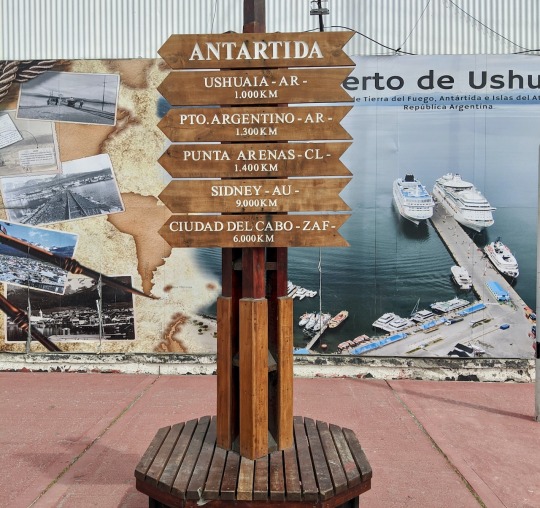
Closer to Straya than to Canada
On my first day there was only a limited amount of people in the hostel. Well, that's what I thought. It turned out that during the day almost nobody was in the hostel ever. In the mornings and evenings though the place was buzzing. In one of the Backpacker groups on Facebook I found Corinna who also just arrived in Ushuaia and was looking for hiking buddies. During the following days we spent the majority of our time together as we got along really well. It's a shame that we have very different plans for our time after Ushuaia, but we figured that we might meet again in Central America.
The first hike we attempted was the one to Laguna Esmeralda. It gave me a first taste of the landscape so far south on our wonderful planet. If I'd have to describe it with one word it would definitely be rugged. There is something quite harsh but beautiful about the environment here - which makes sense, given that we had hardly more than 15 degrees during the day and it's basically winter down here most of the time. The tree line is super low (500m or so), the brownish colour above it is quite unique and the mountain peaks are just spectacular. And best of all, it's all pretty much untouched.
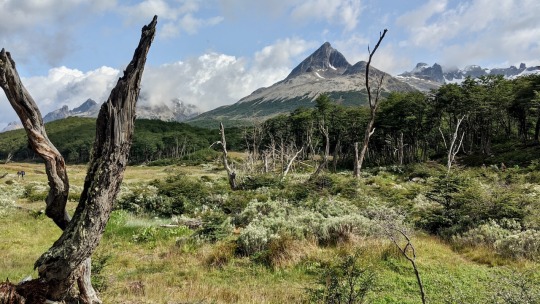
Felt a bit like Lord of the Rings
The hike itself was a lot of fun but not only due to the beautiful surroundings. It was muddy like hell. Parts of it led through peat bogs which I never hiked through before. First we both tried to avoid getting into the mud as much as possible by doing ridiculous detours (we actually almost got lost on the first 500m in) but for me at least the tolerance limit got lower pretty quick. My boots were waterproof and in my hostel they had boot brush cleaners anyway. Walking through peat bogs was pretty weird at first. They have a spongy, springy texture and no matter how dry they look, once you step on it you basically press out a lot of water. The lake itself was pretty nice. Many of the lakes I saw in Canada had the same blue, milky colour but that doesn't make it any less beautiful. Unfortunately I wasn't super lucky with the weather during the whole week but again: It's still just beautiful being out there in the spectacular outdoors of the Land of Fire.
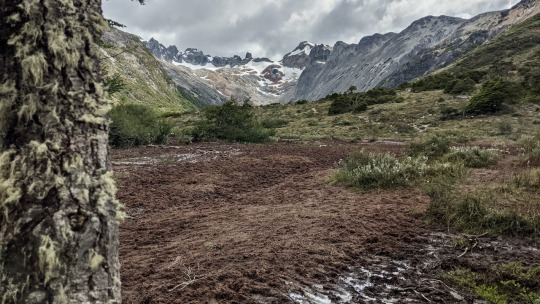
A little bit of mud

Mystic
Next day was rest day. And rest day usually means checking out town and its museums. The first museum I tried was an old prison that Ushuaia is famous for. They've split it up into multiple sections, grouped by topic. I was very disappointed. Firstly, it was totally overpriced and secondly it was just... random. I expected some sort of golden thread when walking through the different prison cells but it felt just like a random collection of stuff. And it wasn't even good stuff. I was hoping to learn a little bit about the history of Ushuaia, the indigenous people who lived here etc. but it was very underwhelming. On the way to the city I had a quick look at a "museum" about the Islas Malvinas which was a huge flop, too so I almost skipped the last museum I had in mind. But thankfully I didn't because that one was finally a good one. Historia Fueguina tells four storylines that are related to Ushuaia’s history:
The indigenous people
One of the first European expeditions
The prison
An unbelievable rescue story about Ernest Shackleton and the Endurance
You wander from section to section, each one consisting of life-sized historic figures while listening to the story on the free audio guides. Most of the exhibits can be entered and you can pose for pictures. It was quite quirky but very educational and a lot of fun. Spoiler: Most indigenous people are now eradicated because the Europeans brought diseases and bullets when they discovered gold in the area. Same shit, different country.
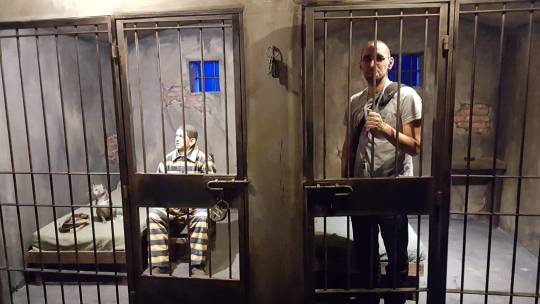
Almost as comfy as my hostel beds
Next thing I did was a little hike up to the local glacier in town: Glaciar Martial. I did this one by myself because I really wanted to start it early and Corinna didn't want to pay for the taxi. It's very popular and I wanted to avoid the crowds. Surprisingly life generally starts late here, mostly around 10am. For this one I left the hostel at 8 and was on my way up at 8:30. And I am very happy about my decision because I had the whole trek for myself. Initially I felt a bit meh about this hike. Most photos in the web are quite underwhelming and the start of the hike is basically just walking along a ski slope. Luckily one of my room mates told me about some side trails and that the hike generally is actually quite nice. I'm glad I listened to him. At the beginning I walked along a beautiful creek with some of the clearest water on earth. After getting to a little viewing area, I continued up to the actual glacier. It became quite steep here, but it also wasn't a particularly long section. At the top I had a wonderful view of Ushuaia and the Beagle Channel. I found a beautiful section where lots of small streams of water merged and just rested here for about 45 mins to soak in the view and some of the sun when it showed itself for a few seconds.
If I remember correctly this was also the very first time that I was making full use of my layering system. I started with my insulated jacket as it was pretty cold in the morning. Halfway through I added my windbreaker as it became quite windy above the tree line. On the way down it gradually became warmer but it also started raining, so I removed both jackets and changed into my rain jacket. Yes, you truly need a good layering system when in Patagonia.
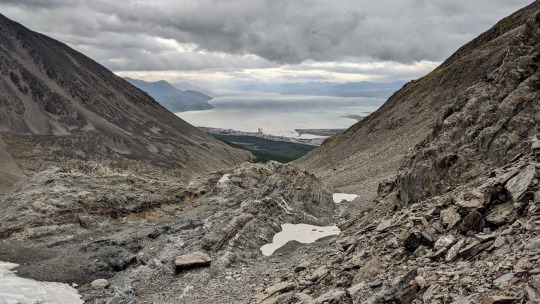
Ushuaia and the Beagle Channel

More Lord of the Rings
The next day was the highlight of my time in Ushuaia. Corinna, the couple that she shared her Airbnb with and I rented a car and we made our way to the Tierra del Fuego National Park. Corinna and I had a crack at the Cerro Guanaco Trail which literally took our breath away. The hike starts at a glacial lake, then turns into a forrest and climbs up pretty steeply. After a while we reached a little viewpoint before going through some muddy terrain again. With the tree line behind us, we were now in pretty exposed and rugged territory and the trail became extremely steep. But we continued, slowly and steadily until we reached the top and a jaw-dropping view to all sides. We could see Ushuaia and the Beagle Channel in the distance, the glacial lake with some impressive mountains below us, ragged cliffs right next to us. It was just spectacular and very close to what I had in mind when thinking about Patagonia.
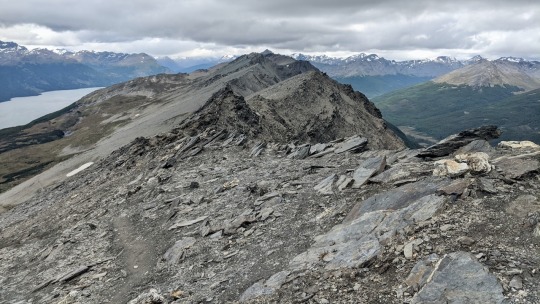
Ragged

My favourite view so far

Corinna and I
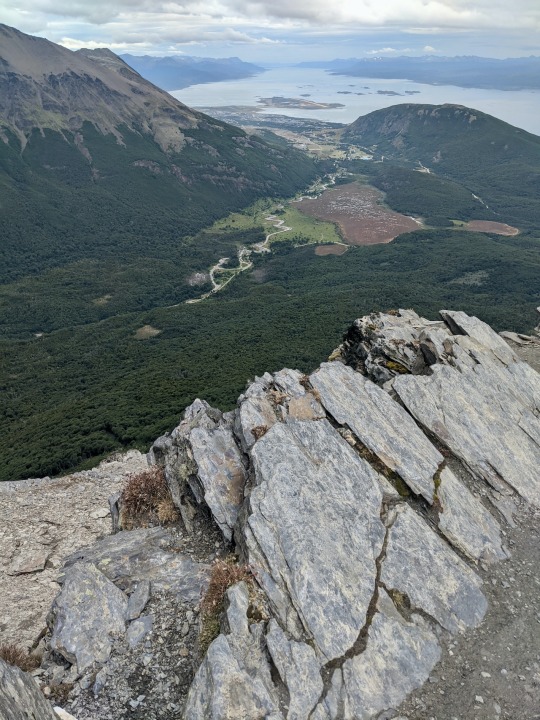
Beagle Channel
After our return we continued to explore the southern part of the National Park, took some dorky pictures at some touristy signs and returned back to Ushuaia. By the way: If I wouldn't know that the water is freezing cold down here I would just love to jump into all the little lakes and inlets here. The water is crystal clear and when the sun comes out and you actually feel a bit warm it is just too inviting...
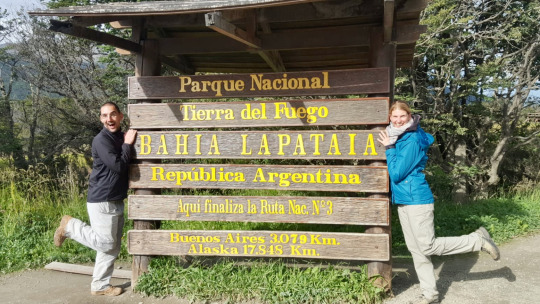
The end of the road

Second best thing to do with these water conditions
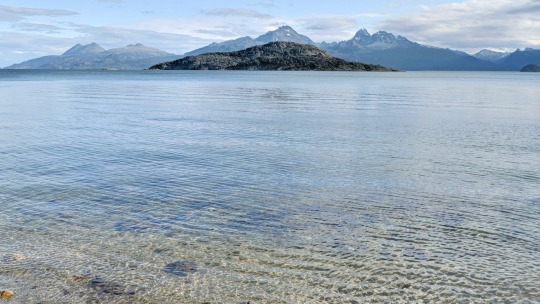
Jump in!
What stroke us the most during our time down here was the very limited amount of wildlife on land. We saw a couple of brumbies (or whatever they call them here), some birds and a few flies, but that was basically it. No guanacos, no armadillos, not even a bloody worm or ant. I actually digged a little hole at one point to see if there is anything hidden in the soil but there wasn't anything. Corinna and I started building a theory that everything we saw was just fake and we were actually in some sort of TV show. I hope you are all very entertained by now!
The last activity I did was a rather disappointing one. Corinna had now left town and I decided to do a little trip to an island full of penguins and a cruise along the beagle channel on my last day. Little Penguins are quite common in Australia and I already saw a lot of them in Melbourne and on Phillip Island. I was hoping that the species they have here in Ushuaia would be a bit more different, but it turned out that the Magellanic Penguins (by far the biggest group of penguins here) are very, very similar. I also saw Gentoo Penguins and a King Penguin though, which was pretty cool. After spending about an hour on the island and some other random stuff on the way there (trees that were shaped by the wind, a museum about marine mammal skeletons (creepy (especially when they showed us the fresh carcasses (let's just add more brackets because I can)))) we started our cruise. And the cruise was just 100% meh. Towards the end we stopped at the famous lighthouse and at a few rocks with sea lion colonies but I guess I'm just too used to these animals so that in hindsights I'm a little angry with myself spending so much money on that activity.

Looks like it's a bit windy out here

The lady was very excited about skinning this skull

Gentoo Penguins

Spot the king!
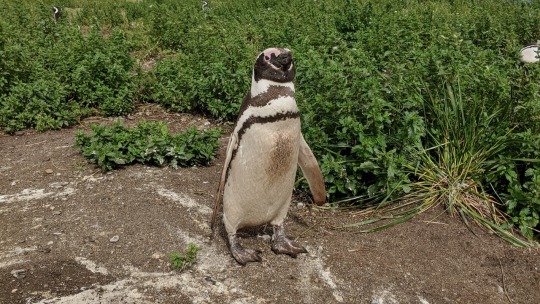
Look at this ugly fella
That was my adventure at the end of the world. I started making some good friends and it was a great start to get to know Patagonia. Next up is El Chalten, the hiking capital of Argentina. Apparently they have really bad internet there, so it might get a little quiet here. Apart from that I also managed to get sick (Coronavirus?), so I'll probably have to rest a bit in the next few days.
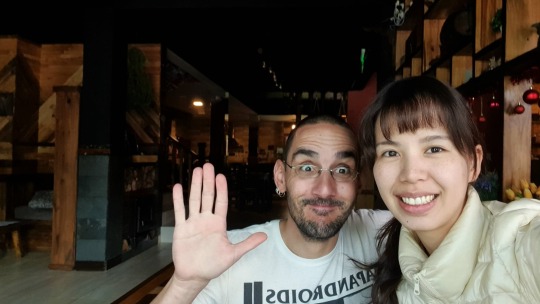
I might meet Jean (who I met in the hostel) again in Bariloche
1 note
·
View note
Text
Every animal face-off in BBC’s ‘Seven Worlds, One Planet,’ rated
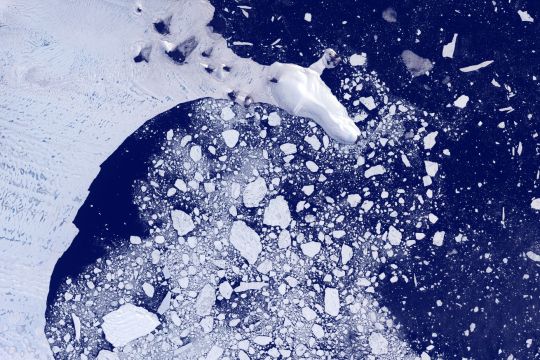
Universal Images Group via Getty
The BBC’s Natural History unit is the stuff of legends. They have been producing beautifully-shot, innovative nature documentaries since before most of us were born, and with the weight of the BBC behind them their productions are only getting better. David Attenborough is a natural treasure in his own right, a brilliant presenter blessed with a voice that is now the gold standard for documentary narration.
All of this you know and don’t need to get from a sports website. But while Attenborough’s new show, Seven Worlds, One Planet, is being reviewed elsewhere, nobody else is willing to ask the most important question about it. Is this sports? And, if so, how sports?
SB Nation has you covered. We’ll grade each scene of each episode for aesthetics, competitiveness and difficulty, and give the definitive answer on what the world desperately wants to know: whether or not what we’ve just seen is sports.
Episode 1: Antarctica
Scene 1: Weddell Seals
You just can’t beat a good cuddle #SevenWorldsOnePlanet pic.twitter.com/2mwzbLN2UG
— BBC Earth (@BBCEarth) October 27, 2019
The Weddell seal is one of the most ridiculous, depressing creatures on the planet. It is, as far as I know, the most southerly-living mammal, staying close to the Antarctic landmass even in deep winter. Since it’s a seal, it needs to breathe air, and so it spends all winter gnawing away at the ice to prevent its breathing holes from freezing over. Chewing ice all your life is a good way of wearing your teeth down quickly, and when that happens, no more breathing. Weddell seals, as Attenborough says, die young.
Why do they live like this? It’s simple: spending winter on the Antarctic ice shelves means that there are no predators able to interfere with the breeding season (which technically takes place in ‘spring’, but if any spring deserves scare quotes ...). Of course, that also means their pups are born into the most brutal environment in the world, and until they learn to swim, they’re left exposed to storms.
Seal pups have their mothers for protection against the worst of the blizzards, but when a storm gets bad enough, the adults are forced to seek shelter underwater. The babies then have to fend for themselves against the howling fury of an Antarctic storm. This seems unpleasant.
Aesthetics: 5/10
Seals are cute, but not very sporty, especially if we see them mostly out of the water, where they’re at their worst. And Weddell Seals, while philosophically impressive, are not the most visually appealing pinniped.
Also they spend most of the time in a blizzard, which dampens the appeal. And there’s video of a seal birth. There has never, in the entire history of the world, been an aesthetically appealing birth.
Difficulty: 10/10
If you tried to do what those newborn seals did, you would die 100 percent of the time. I don’t care how tough you think you are: you’d be dead. Maximum difficulty points.
Competitiveness: 0/10
‘Baby seal vs. blizzard’ isn’t really a competition, and it’s not like they’re fighting each other. NB: Would watch baby seals fight each other. Think of the floof.
Overall: 15/30
Not sports. Incredible, but not sports.
Scene 2: King Penguins
Ahhh that relatable feeling of a giant ball of fluff stuck in your mouth. #SevenWorldsOnePlanet pic.twitter.com/kI7nLTsyHM
— BBC Earth (@BBCEarth) October 27, 2019
Half a million penguins jam themselves onto one beach on the island of South Georgia to raise their chicks. When the parents go off to fish, the chicks are meant to stay where they’ve been left. But sometimes they don’t! Naughty penguins!
Honestly, it’s hard to know what to make of king penguins. They’re beautiful, graceful animals (well, the adults are), despite what Herman Melville might have to say about general penguinkind in his Encantadas:
What outlandish beings are these? … Their bodies are grotesquely misshapen; their bills short; their feet seemingly legless; while the members at their sides are neither fin, wing, nor arm. And truly neither fish, flesh, nor fowl is the penguin … without exception the most ambiguous and least lovely creature yet discovered by man. As if ashamed of her failure, Nature keeps this ungainly child hidden away at the ends of the earth.
But kings suffer when there are emperors about, and there’s no exception here. King penguins are like emperor penguins except smaller and shittier, and as a result it’s hard to take them seriously. Naughty penguins.
Aesthetics: 8/10
More floof balls! Except this time there are more of them and they’re not being absolutely battered by a blizzard, which improves things. Also, they sometimes chase smaller floof balls, and that’s fun.
Difficulty: 5/10
The penguin chicks’ jobs involve standing still and waiting for their parents to come back. This sounds easy, but y’all can’t even sit there for like 10 minutes without checking your phones, so ...
Also, a bonus point for one of the penguins being enough of a badass to peck an elephant seal. Incredible.
Competitiveness: 2/10
Getting lost is annoying, but not competitive. I guess at one point they have a mild battle over a small ball of fluff?
Overall: 15/30
Not sports either.
Scene 3: Elephant Seals
Just two giant roly sea doggos having a disagreement, nothing to see here. #SevenWorldsOnePlanet pic.twitter.com/dtt7bub88A
— BBC Earth (@BBCEarth) October 27, 2019
Find me a nature documentary about the Antarctic without footage of male elephant seals FUCKING EACH OTHER UP. That’s right. There are none. Elephant seals can weigh up 8,000 pounds and get to 20 feet long. They are angry, hefty and horny, and they hate each other. They express this hatred through squaring up to one another and engaging in teeth-bared body-slamming, and it gets extremely bloody. Even though they’re protected by a layer of blubber almost 10 inches thick, elephant seals frequently hurt each other very badly.
This all leads to some good television and you’d be a fool not to take advantage of it. The BBC are not fools.
Aesthetics: 7/10
If you’re into big hefty boys going at it, go ahead and give this scene an extra point. But heft alone does not a perfect scene make, and the sheer gracelessness of an elephant seal battle means we’re going to have to ding it some points.
Difficulty: 10/10
Imagine being fallen on by a four-ton seal. Now imagine that seal has huge teeth and is simultaneously trying to tear your neck open with them. Another scene which would definitely kill you, me, and everyone else who might ever read this.
Competitiveness: 9/10
An all-out fight over breeding rights between two monster seals? Yes. Yes, this is the good stuff. It’s not the best or longest elephant seal battle ever recorded, but there has never been a bad one.
Overall: 26/30
Definitely sports.
Scene 4: Humpback banquet
Ahhh yes the ye olde spiral, bubble, snatchy-grab fishing method. #SevenWorldsOnePlanet pic.twitter.com/XUfF3GfJQ1
— BBC Earth (@BBCEarth) October 27, 2019
Humpback whales might not be the biggest whales in the ocean, but they’re probably the most interesting. Their social behaviour is (or seems) more interesting than the rorquals, and their hunting behaviour is also extremely cool. Here a shoal of humpbacks is concentrating a swarm of krill by using ‘bubble netting’. Since krill won’t swim through the bubbles they breathe out, the whales can control their movement, which makes them easier to eat.
This is a short scene, but it’s worth including.
Aesthetics: 9/10
I’ll be the first to admit it: I’m a whale person. Not, like, physically: the flippers would make typing difficult. But I’ve always loved whales. They’re huge, beautiful, and they do cool shit like make bubble spirals in the ocean. And these are particularly good bubble spirals.
Difficulty: 8/10
I can also blow bubbles underwater, but I imagine I’d be practicing for Gladwellian hours before I got good enough to herd krill. Also, imagine trying to fit that many in your mouth at once. Challenging.
Competitiveness: 2/10
I have to admit that a half-inch shrimp thing vs. a whale is not much of a fight, even if there are billions of the little fuckers.
Overall: 21/30
Probably sports? In my ideal world, synchronised bubble-netting would have a place at the Olympics.
Scene 5: Grey-Headed Albatross
All by myself...don’t wanna be, all by myself #SevenWorldsOnePlanet pic.twitter.com/sBQqSu2ojk
— BBC Earth (@BBCEarth) October 27, 2019
Albatross? Albatrosses? Pluralising these things is annoying. Anyway, the scene. As it turns out, climate change is messing with, well, the climate, and that has had the effect of increasing wind speed on storms in the Southern Ocean, and making those storms more frequent.
Grey-headed albatross(es) breed right in the path of these storms, and that means that when chicks are left alone they have to hunker down in their nests against the fury of 70 mph winds. Unsurprisingly, many fail. And if they’re blown out of their nests, thanks to a twist of evolution, their parents don’t recognise them until they get back in. And that means they’re on their own until they can climb back. Are baby birds good at climbing? Reader, baby birds are not good at climbing.
Attenborough tells us that this particular grey-headed albatross colony is going through a massive decline. I believe it.
Aesthetics: 5/10
I’ve seen cuter fluffballs. In this very show, even! A bonus point for the adults being so beautiful, though. Seagulls may be ugly as sin, but make them large enough to glide and suddenly you have yourself some majesty.
Difficulty: 6/10
Ok, the windchill would be unpleasant, but I could climb into those nests.
Competitiveness: 8/10
The chicks are struggling against their own tiredness and lack of climbing ability. Is transcending yourself the core of all competition? Probably.
Overall: 19/30
Possibly sports? Mostly sad, to be honest. Here we have the Ottawa Senators of the natural world.
Scene 6: Gentoo Penguin vs. Orcas
A desperate dash, this penguin must use all its acrobatics in an attempt to evade the orca. #SevenWorldsOnePlanet pic.twitter.com/WhNEFuhRtJ
— BBC Earth (@BBCEarth) October 27, 2019
Oh, my God. This is possibly the coolest thing I have ever seen. Penguins are incredible underwater. They’re agile, smart and fast. Killer whales, however, are faster and smarter, which means the only possible hope a penguin chased by a whale has is to use its advantage in maneuvering to somehow find an escape route.
The cinematography in this scene is exquisite. As the chase is right up at the surface, with the penguin frequently jumping out of the water and right over the whales, drone footage lets us see the whole thing play out from above, giving us a full-field perspective on a dogfight which would make a WW2 fighter ace whistle in appreciation. This is unbelievable.
Unfortunately it’s also four orcas against one penguin. So, uh, you know how it ends.
Aesthetics: 10/10
I would hang this scene on my living room wall, and then stare at it for several hours a day. The sheer power of the orcas combined with the dazzling agility of the penguin and the overhead view makes this scene extraordinary even for a BBC nature production.
Difficulty: 10/10
Those underwater cuts! The repeated jumpings-over of whales. This is nature at its most difficult. That poor, heroic little penguin.
Competitiveness: 5/10
All right, so four big whales against one penguin is not much of a fight.
Overall: 25/30
Definitely sports. And although it’s tempting to ding it because of the lack of competitiveness, some of y’all will sit through the Patriots playing the Dolphins.
Scene 7: Gentoo Penguin vs. Leopard Seals
Me attempting to make friends #SevenWorldsOnePlanet pic.twitter.com/UixNpVVJkg
— BBC Earth (@BBCEarth) October 27, 2019
Melville would enjoy the role mid-sized penguins serve in the Antarctic food chain. They sit in the middle, eating small fish and krill and in turn being eaten in large amounts by the continent’s coolest predators. We’ve already seen orcas, so now it’s time for leopard seals to get in on the action.
Leopard seals are vicious things. They’re 10 feet long and their jaws are almost crocodilian, evoking thoroughly un-seal-like feelings when you look at the rows of big, interlocking and very lethal teeth. They like eating penguins. And, like the albatross chicks, climate change isn’t helping the gentoos — the region’s glaciers are falling apart, leaving acres of ‘brash’ ice between the penguin colonies and the open ocean. This ice is hard for the penguins to navigate, and perfect for an ambush predator.
The penguins have to scrabble over blocks of ice that could crush and kill them while being stalked from below by a hungry monster seal. That sounds like a bad day to me!
Aesthetics: 6/10
We’ve seen Weddell seals and elephant seals, but leopard seals are very different and altogether nastier critters. They’re not without their charms, though, and watching a top predator at work is sort of fun. Even if they’re extremely brutal.
One mark off for the bit where both penguin and seal end up on an iceberg. Neither is anything but ridiculous-looking out of the water.
Difficulty: 9/10
Depending on your point of view, this is either very easy — the penguins are sitting ducks — or very hard. Trying to scrabble through the floating ice to get to open water looks utterly miserable.
Competitiveness: 6/10
Some of these penguins put up a pretty impressive, and pretty surprising fight. Good work, little critters.
Overall: 21/30
Probably sports? Swimming is a sport. Climbing is a sport. Ice-scrabbling ... not a sport, yet, but we’re open-minded here.
Scene 8: Under the ice
Sorry, can’t right now, bit tied down. #SevenWorldsOnePlanet pic.twitter.com/HqHlcVnv6B
— BBC Earth (@BBCEarth) October 27, 2019
Below the Antarctic ice, conditions are surprisingly friendly, and inveterate drama plays out in slow motion. Starfish and urchins are chased by huge predatory worms. Blind nudibranchs search for mates in miniature forests of sponges and anemones. Those anemones are hunted by jellyfish — or so the jellyfish thinks, anyway.
Aesthetics: 4/10
Cool, in a creepy, slow-motion way.
Difficulty: 2/10
Looking for food and mates must be quite hard when you can’t move very quickly and you can’t see very well.
Competitiveness: 2/10
Jellyfish vs. anemone is an interesting but quite one-sided battle.
Overall: 8/30
Not sports at all. Getting a look under the Antarctic ice is neat anyway.
Scene 9: Right whales
“They were so trusting and inquisitive that they swam right up to the whaler’s boats. And the whalers called them ‘right whales’ because they were the right whales to hunt.” #SevenWorldsOnePlanet pic.twitter.com/KU8bBA7BF0
— BBC Earth (@BBCEarth) October 27, 2019
20th Century whaling, which happened on an industrial scale, nearly wiped out every species of great whale. And southern right whales, the easiest, slowest, most-inquisitive targets, were hit the hardest. 99.9 percent of the population was killed — but frankly it’s a wonder any of them survived at all.
In the years since the whaling moratorium, however, the tiny fraction of survivors has proved robust enough to begin a small, fragile recovery. It’s grim times on the planet, and hope is nice to have.
I assume you were expecting a Melville quote here, and a rather gloomy southern right whale (still gloomier after it has its head removed) does indeed make an appearance in Moby-Dick. But, friends, I refuse to be that predictable.
Aesthetics: 2/10
Right whales are ugly, ponderous things, devoid of the grandeur of rorquals and humpbacks. And the bay in which this scene is shot is also too murky for good filming.
Difficulty: 0/10
Nothing happens!
Competitiveness: 0/10
Nothing happens!
Overall: 2/30
Pretty much the least sports possible. But a) it’s good to hear that the whale population is starting to recover and b) there was still more action than in that San Francisco-Washington game a few weeks back.
Overall sports tally: Some of this is sports
Two are definitely sports, three probablies, and four nos. That’s not a bad rate, and to be honest it’s a fantastic nature show and you should watch it, even if you’re mostly in it for the sports. Also, and I don’t want this to sound like a throwaway note at the end of an article, even though it is: CLIMATE CHANGE IS TERRIBLE AND WE NEED TO DO SOMETHING ABOUT IT. AS A COLLECTIVE, NOT JUST INDIVIDUALS. ME COMPOSTING DOESN’T SEEM TO BE DOING SHIT. Thanks.
0 notes
Link
Well, things got a little interesting!
My unemployment ended a bit earlier than anticipated -- I'm now doing contract work for WB! Got a gig for the next handful of months, mostly working remotely from home helping out with Unity stuff. Just started only last Thursday, but so far so good!
It's definitely a nice opportunity and I'm really glad it worked out, but at the same time I definitely felt a bit of pressure knowing that my unemployment days were over, at least for now. The usual flurry of thoughts ran through my mind -- "Did I do enough?" "I'm not going to have enough time to do these things now." "Did I really make the most of my time?" At the same time, I've always wanted to try my hand at contract work anyhow and this was definitely the perfect opportunity to do that.
Right before that, I got hit by some sort of death plague that has been sweeping across everybody, which was not fun, though it certainly was a great chance for me to just stop doing everything and just focus on relaxing. Fortunately it only really lasted for a week, and the worst of it was really only three days, but I haven't really felt that bad in a while. Brings back some unpleasant memories of some other times that I have been really sick =( On the plus side, I had absolutely no trouble falling asleep for a while because of that. On the other hand, waking up in the morning was like the absolute worst thing ever...
I missed out on a bunch of dance stuff while I was busy being super sick, so I decided to stop by South Bay Fusion and Gentoo Swing this past week to make up for it. I won't really pretend that I really broadened my dance horizons, but it was certainly cool having the opportunity to push outside what I normally do and see some other scenes (I have not been to South Bay Fusion in many years). I guess I did end up reaching a couple of conclusions, not necessarily directly related to those days but inspired by them. One is that I don't play follow nearly enough for how much more fun it can be than leading and I wonder despite all I've said and done, if that is because I'm closer friends with more follows, or if it's just because I'm falling into the same gendered social norms as everybody else. Don't get me wrong, leading is great, especially for some dances, but I think there is something more there and I wonder if it is preventing me from having as great of a time. I won't pretend I don't have my personal preferences and I still daydream romantically about the day when a girl will lead me in a dance and sweep me off my feet, but...
The other thing that occurred to me is just how well I understand waltz compared to everything else and the feeling of confidence and ease that brings with it. I mean, that is of course only expected given how much time I have put into the dance as well as the amount of enjoyment I have gained from it. It's not like I never dance other forms of course, though we all know I love to stay in my comfort zone (not just in dance), but I think it was elucidating to have it illustrated to clearly to me how much more of an understanding I have and how much more "fluent" I am in that language compared with others. It actually reminds me of when I first started to have one or two very close and very real friendships and how other relationships started to feel a bit hollow and less rewarding in comparison, because that deeper understanding just wasn't there. I'm sure others have had that experience as well, maybe not in the same way but in some manner.
Like I said, I'm always for staying in my comfort zone, but I also place a heavy emphasis on staying true to what came before. If I had to name something that bothers me most in other people I think it would definitely be that I find people to be passionate and interested about things one minute and lose interest the next. I don't think that is a bad thing inherently, it's just something that I personally am really not about. It makes me feel like nobody is actually serious about things, that they are fickle and can't be relied on. And of course it's the same for dance too. The interesting thing about dance is that for me I think to "stay true to what came before" does not necessarily mean always doing the same things over and over again. Because for many people, myself included, dance involved a lot of discovery and experimentation when we first became involved in it. And I think to be intensely passionate about learning more, and then do a 180 and feel jaded about anything new, is its own form of moving on from something perhaps without good reason to do so. I'm not trying to call that behavior out or anything, just saying that that's what I feel ought to be a personal virtue for me.
Anyways, I thought that was kind of interesting since I feel like complacency is not something I am usually afraid of, but maybe in this case I ought to be. I think there are many people who become complacent in dance, some of whom I think it totally makes sense and I approve of, and others whom maybe it doesn't. But I'm sure there are many many people who learn one dance role, become comfortable with it, and then just don't feel like starting from ground zero again to learn the other one. Because that would involve going through all of those same things again. And I think things like that sort just feels like a shame for people who were so excited about learning them in the first place. But who am I to judge, really?
Putting all that aside, I've actually had some really great days recently. I have not been getting a lot done, which I'm sure will start coming to stress me out soon (sigh........), but I have been having a lot of fun and enjoying myself and some great company too.
I know my "unemployment break" is over, but that doesn't mean that I'm not still thinking about self improvement. And when I say "self improvement" I mean "self regression" because to me "regression = improvement"...anyways, like I've probably said before, I'm still searching for a greater feeling of peace and "quietesse" (not a real word), one that I used to have and one that Sayuri knew quite a lot about. I almost wonder if I ought to see what she has to say about it someday.
Let's all keep doing our best to hold onto what is important...
0 notes
Text
Linux Life Episode 40

Hello folks and welcome back to my Linux Life. So I have been wondering something regarding my Linux adventure. Now I have moved to ArcoLinux B Cinnamon I have been happy with my Linux experience. I even installed some themes.
However I have noticed certain types in the Linux community.
First is the Minty people who are normally newbies to the Linux world. Linux Mint is a pretty safe option as it doesn't have a steep learning curve and most of the Linux software is available. Not the worst place to start. Also in this group is the Ubuntu users and those using Elementary. The software is updated when declared stable and kernel updates normally only come with an update version of the system.
The old school Linux guys who like using terminals and things like Gentoo and Debian. These guys tend to have their own servers. Build their own kernels or swear by LTS versions. They use only free software unless forced to use a proprietary driver (looking at you Nvidia). Know how to write scripts, what things like systemd and systeminit do and what differences they have. They tend to use only older versions of software that they know works and very rarely update it once they find their ideal setup.
This was the ipso facto archetype most associated with Linux for a long time. This is due to interviews with Linus Torvalds (the creator of Linux) this is how he came across.
Then there is just the everyday users who know enough to get by, have played with Linux enough they can fix the occasional issue but if anything major happens they may have to ask online. These people are not so fussy with Linux as long as it runs what they want. These are your Fedora, Mageia and OpenSUSE users. They will recommend their version but not really fussed if you like something else.
Then there is the Arch people of which I am now part of . It seems that people who use Arch are a bit pretentious if you are to believe what you read on Linux boards or YouTube video comments. Obviously Arch is a rolling release and updates regularly meaning you always have the most up to date systems. Some believe this makes it unstable.
Now this is odd as if you use base Arch Linux you have to set up from source pretty much like Gentoo so it should be popular with the diehards.
However as there is now many distributions such as Manjaro, Antergos, ArcoLinux, ArchSwag and more which make it a lot easier to install it is not much harder than Mint to install.
However Arch users are seen as this evangelical group by Linux users. If they use Arch they will tell you. Which is pretty ironic considering for years you ask anyone in computing and they said the exact same thing about Linux users. If you used Windows or anything else Linux users would be I use Linux and were seen as evangelical.
Funny how the world is cyclical. Obviously in this list I have not included the corporates or the security paranoid as they have their own criteria. It's a funny world.
Some people have asked me which Linux I ultimately think is best. The answer is it depends what you want Linux to be. This is why everyone has a different experience regarding Linux.
I had to find the one that suited me. What suits me, you may absolutely hate. You need to experiment that's what I did.
People go on about distro hopping. Changing from one different version of Linux to the other. Some think it's a bad thing, some good.
It's good that you have many choices available to you and distro hopping means you can try them all.
Distro hopping is not good if you are running a server which has many files and accounts many of which will need reassignment to work again.
Do you need a Linux system for current hardware or older hardware or a mixture. Whatever it is, there is probably a distribution that covers it. Even more so now Real Time kernels are becoming popular.
Play around with a system like Virtualbox to have a look at various distributions running. While not perfect will give you an idea what is available.
The other day I was thinking do I really need a rolling release version of Linux ? The honest answer is probably not. I don't have the latest hardware. I used to create podcasts, magazines and video stuff but I have not done that in probably over a two years or more.
Now most of my time in Linux is spent browsing the web, watching YouTube, writing blog entries in word processors and emulating stuff in the form of OS stuff in Qemu and Virtualbox or games using various emulators available to me.
I used to try and install Windows stuff using Wine, but to be honest I have not done that in a while either as there is no particular Windows program I need at the moment.
So none of the stuff I use is updated often. So why do I need a rolling release. The answer is simple I probably don't. However I do like the fact that I do have the available options should I ever need to.
Sure people could say well you could install the latest versions from PPAs if you used a fixed release version. Well there is the crux.
Due to Arch having the AUR and regularly updated repositories it's very rare that I have to go elsewhere to get programs.
So far it has been one and that was GDash from Bitbucket. Only because the Git version didn't seem to want to work that was listed in the AUR. I'm sure it's fixed now but that was the only program I had to download the source and build it manually from terminal.
To be honest I very rarely use terminal it's just not generally required the way ArcoLinux is set up. I'm not saying I have never used it I have. But it's not very often.
Normally it's when I have had to move a file as root but that has been very few and far between.
Could I go back to the likes of Mint and co... Probably not as I find the Arch system much easier to maintain. I have yet to have the system break on me due to update. I have had it break due to me messing with certain config files but that wasn't it's fault but mine for not really knowing what I was doing at the time.
Even if an update fails for some reason which only happened once with a Perl 5 update when I used Antergos within an hour someone had updated the script and it worked.
Also if there is conflicts in Arch it tends to tell you what it is and what's using it. So you can normally sort out the issue.
Manjaro was the only Arch distribution I had issues with. Strange considering it is listed as the Number 1 on Distrowatch for many months.
It installed fine but refused to set the Nvidia driver correctly, sticking me at 640x480 and refusing to change. Also when installing stuff from the AUR it would stop due to the script being in the wrong order.
Antergos and ArcoLinux both examine the script and if the order is wrong correct it on the fly so it can install. This was prevalent when trying to install Shutter.
Manjaro stopped four times and I had to install certain libraries individually to continue. The other two just changed the compile order so the libraries were made in the right order.
Also I don't know why but I like the fact that I have the latest versions of software. I may not be on the bleeding edge of requirement but if I ever decide I want to be I know it will cope.
Anyway that's enough waffle for this episode, so until next time ... Take care.
0 notes